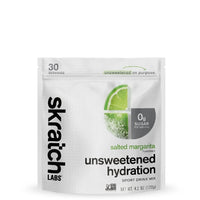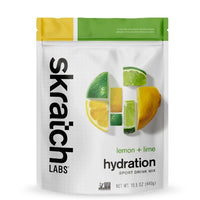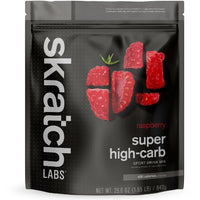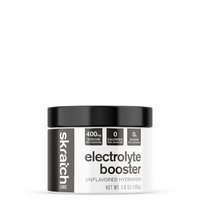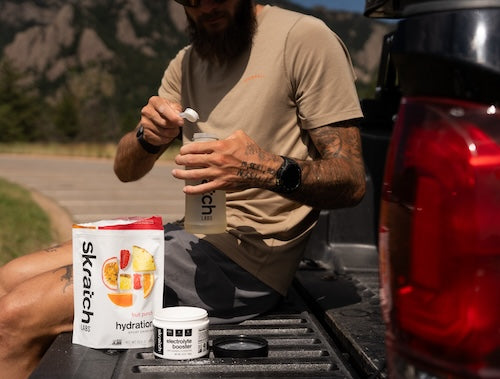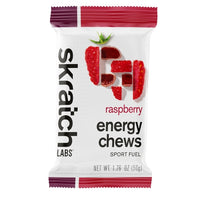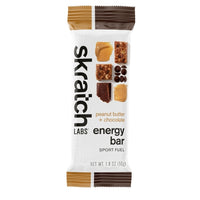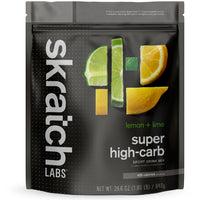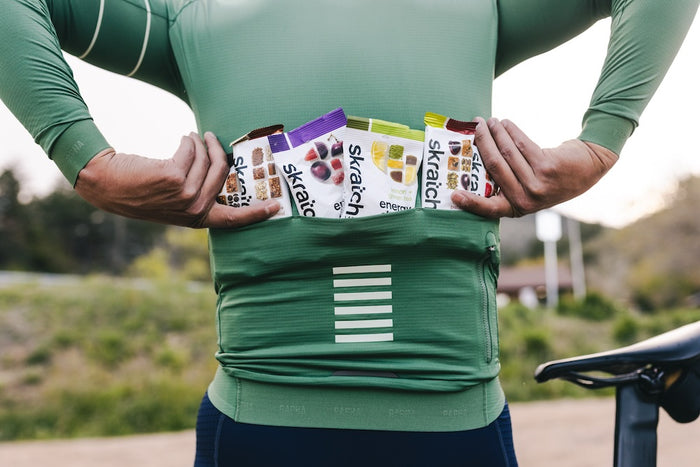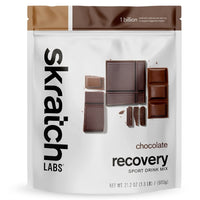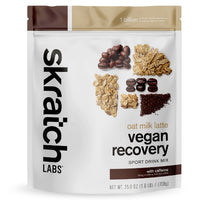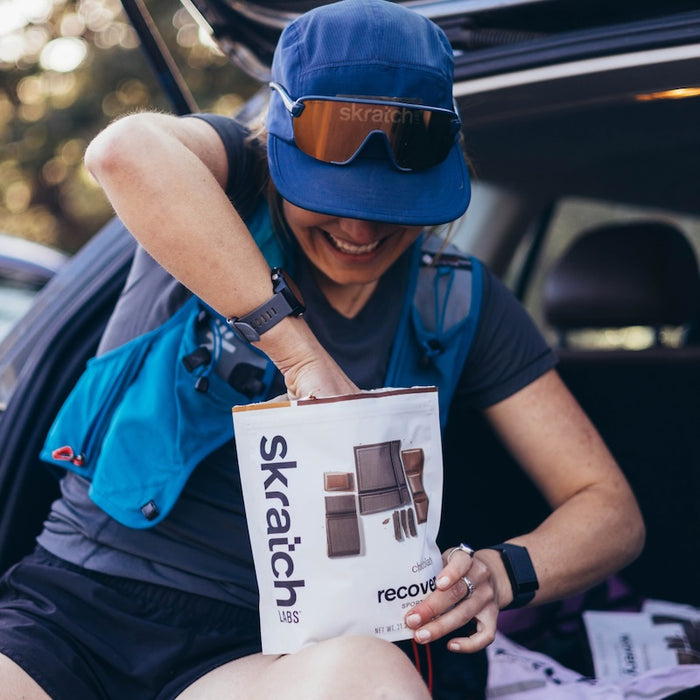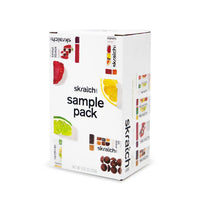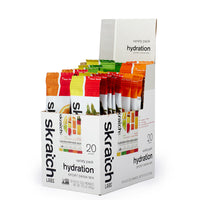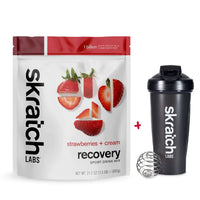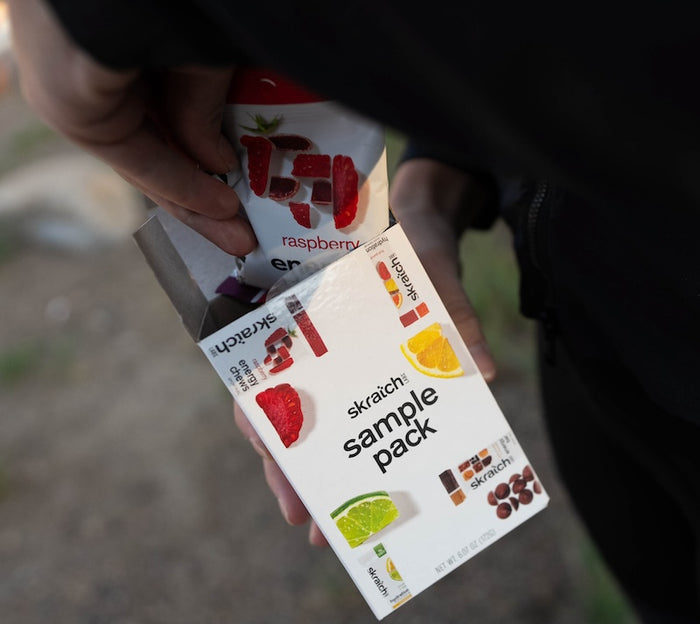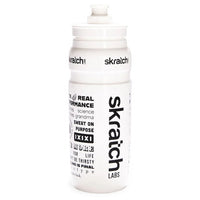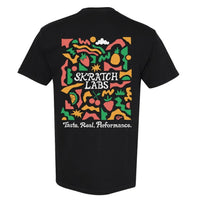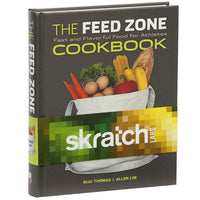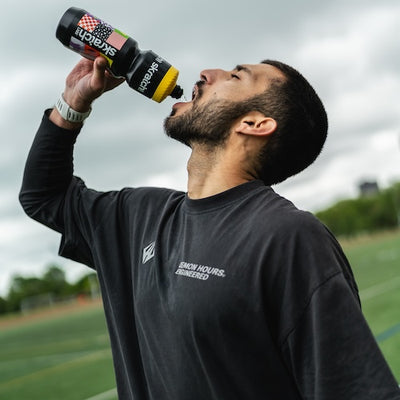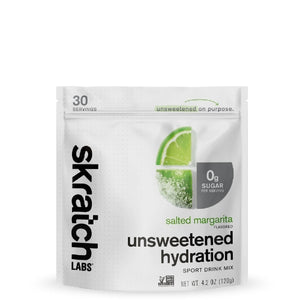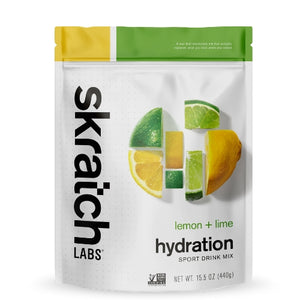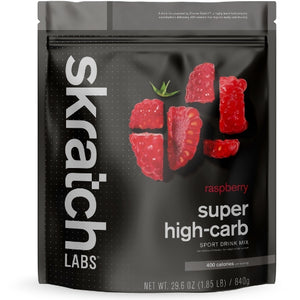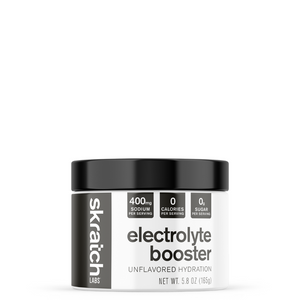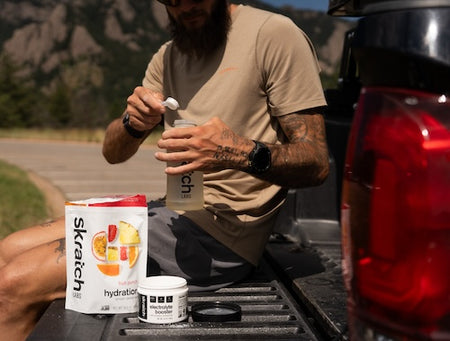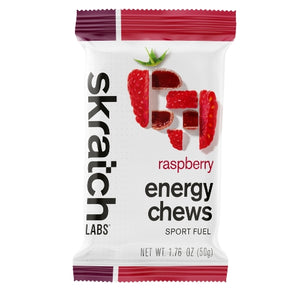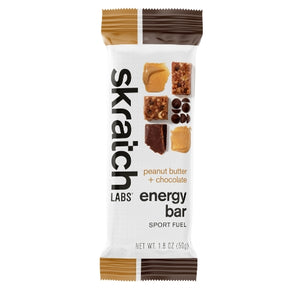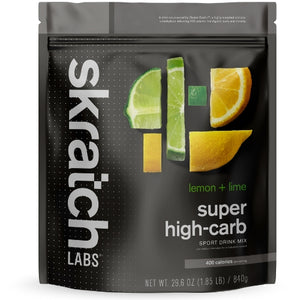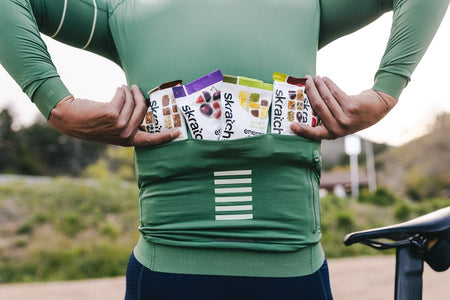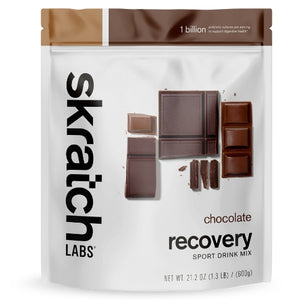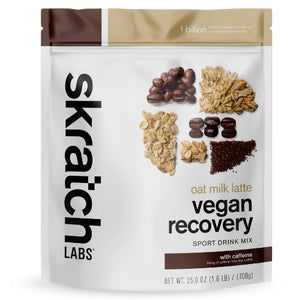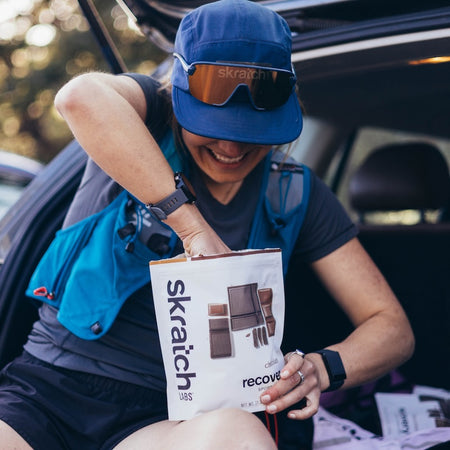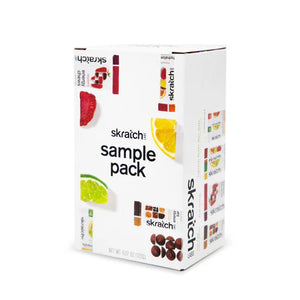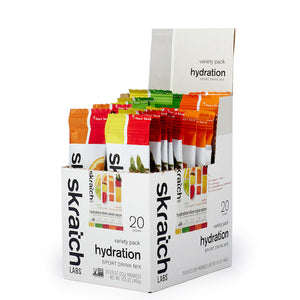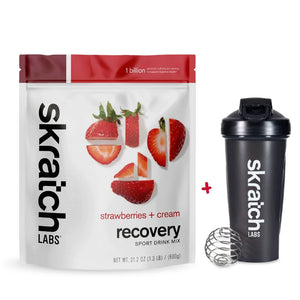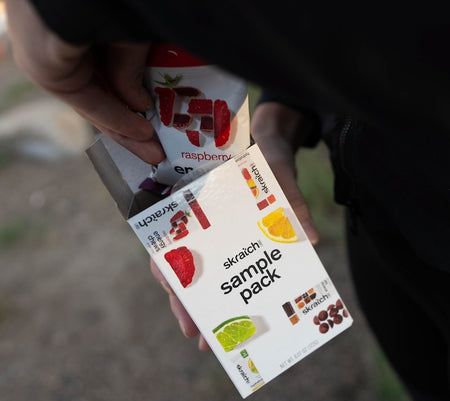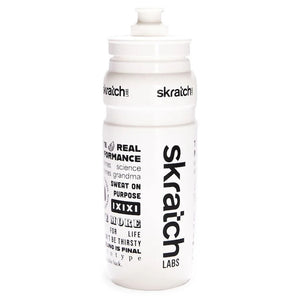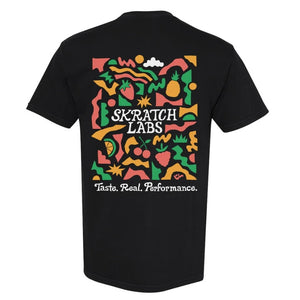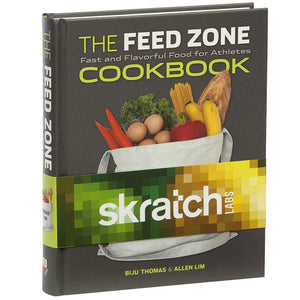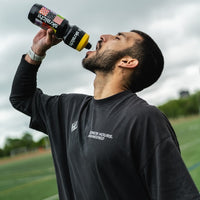When it comes to recovery, our philosophy is simple: give athletes what they need, when they need it, in the simplest, most delicious way possible. That’s why we created the Skratch Labs Recovery Sport Drink Mix—a high-calorie recovery drink made with real ingredients, optimized for fast refueling after your hardest efforts. No gimmicks. No artificial nonsense. Just real food for real performance...But this wasn’t always our stance...
Why We Gave Up on Recovery Drinks (Before Making a Better One)
Recovery drinks used to be more science project than sustenance—loaded with synthetic additives, harsh flavors, and lofty performance claims that didn’t hold up. Athletes would choke them down out of obligation, not joy. We got so fed up, we ditched recovery drinks entirely and cooked real meals post-workout instead—chicken fried rice on the team bus, for example.
It worked. Athletes felt better. They were happier. And that human connection to real food inspired the Feed Zone Cookbook.
But real talk? Cooking every time wasn’t always realistic. Athletes needed something quick, effective, and delicious when fresh food wasn’t an option. So, we set out to build a better recovery drink, one rooted in science, but driven by care. The result is Skratch Labs Recovery Sport Drink Mix: a thoughtfully balanced formula designed to restore what’s lost after long, hard efforts.
What's Inside (and Why It Works)
We based our mix on a 4:1 ratio of carbohydrates to protein: the gold standard in post-exercise recovery. Each 12 oz serving includes:
- 35-40g simple carbohydrates (from glucose, sucrose, and lactose)
- 8-10g complete protein
- 3.5-5g fat
- 270-340mg sodium (for rehydration)
*varies based on flavor and dairy vs. non-dairy options
It’s everything you need to shift from breakdown to rebuild mode…fast.
And for those who prefer or require a plant-based option, we now offer a Vegan Recovery Drink Mix, carefully formulated to deliver similar macronutrient ratios using plant-based proteins and carbohydrates. Same purpose, different tools.
Carbs: Why Simple Sugar Isn’t the Enemy
We get it, sugar has a bad rap. But when used in the right context simple sugars are exactly what your body needs. They spike insulin, trigger glycogen resynthesis, and accelerate recovery. Used at the wrong time (like sitting on the couch)? Sure, that’s a problem. But after a hard ride, run, or race? It’s fuel and how you rebuild to go again hard the next day.
Some brands avoid sugar by using maltodextrin—a complex carb that doesn’t look like sugar on the label, but behaves like one (or harsher) in your body. It digests quickly, spikes blood sugar even faster than sucrose, it can also cause GI distress.
That’s why we chose a combination of glucose and sucrose: simpler, more transparent, and better tasting.
Protein: Complete Milk Protein > Whey Alone
Not all proteins are created equal. Many recovery drinks rely on partial proteins like whey isolate, but we use complete milk protein—a naturally occurring combo.
Why? Because:
- It contains all 9 essential amino acids.
- It has the highest biological value and digestibility.
- It digests at both fast (whey) and slow (casein) rates.
- It tastes better and acts as a natural emulsifier—no soy lecithin needed.
If nature already made the perfect blend, why mess with it?
(And again—for those who can’t tolerate dairy, our Vegan Recovery option is a strong plant-based alternative.)
A Deeper Look: Recovery, Digestion, and Muscle Synthesis
When you finish a hard workout, your body is in a catabolic state—breaking down muscle tissue and burning through glycogen. To reverse this and shift into recovery, you need insulin. That’s where simple sugars come in. They help spike insulin levels, which accelerates glycogen resynthesis and enhances muscle protein synthesis.
Here’s what’s happening under the hood:
- Insulin sensitivity is highest immediately post-exercise, especially in the muscles just worked. That means more of what you eat gets stored in muscle, not fat.
- Glycogen storage is time sensitive—the first hour after exercise is critical. Miss that window, and your ability to replenish efficiently drops.
- Protein synthesis needs essential amino acids—particularly leucine, a key trigger for muscle rebuilding. Milk protein provides more leucine per gram than most other sources.
- The balance of fast- and slow-digesting protein (from whey and casein) ensures your body gets a quick hit of amino acids and a steady stream over time.
This is why our Recovery Sport Drink Mix works so well. It doesn’t just check boxes on a nutrition label, it fuels your physiology when it’s most ready to receive it.
Sodium, Hydration & Fluid Retention
Recovery isn’t just about calories—it’s also about fluid and sodium. We included enough sodium to begin rehydration and help restore what’s lost in sweat. Combined with the natural electrolytes and slower digestion of milk, this formula helps retain more fluid than water or typical chocolate milk or sports drinks alone.
Who Is It For?
This isn’t a casual smoothie. Our Recovery Sport Drink Mix is designed for athletes who have just put in serious work—whether that’s a multi-hour endurance session, back-to-back races, or an all-out training block.
If you’re depleted, hungry, and in need of something fast and effective, this mix is your sharp tool. It’s not the whole meal but it’ll cut through fatigue and get you back on your feet.
Real-World Feedback
Before launching, we tested our formula with real athletes, including those training for the Olympics and Tour de France. The response? Overwhelmingly positive. Athletes told us they felt better, recovered faster, and maybe most importantly, actually looked forward to drinking it.
For us, that’s the ultimate success: science-backed nourishment that brings joy.
Final Thoughts
At the end of the day, recovery is about replenishing what was lost: glycogen, fluid, sodium, and amino acids. Real food can do that—and so can our Recovery Sport Drink Mix, especially when you’re too tired, busy, or remote to cook.
It’s a delicious shortcut. A caring solution. A bridge between hard work and feeling like yourself again. No fridge - no problem. Longer shelf life compared to perishable dairy products like regular chocolate milk. Just add water, mix, kick your feet up and recover.
Whether you reach for the classic dairy version or our vegan formula, we made this to help you rebuild stronger, faster—and with a smile.
References:
- Pritchett, K. L., Pritchett, R. C., & Bishop, P. (2011). Nutritional strategies for post-exercise recovery: a review. South African Journal of Sports Medicine, 23(1), 20–25.
- Millard-Stafford, M., Childers, W. L., Conger, S. A., Kampfer, A. J., & Rahnert, J. A. (2008). Recovery Nutrition: Timing and Composition after Endurance Exercise. Current Sports Medicine Reports, 7(4), 193–201.
- Betts, J. A., & Williams, C. (2010). Short-Term Recovery from Prolonged Exercise. Sports Medicine, 40(11), 941–959.
- Berardi, J. M., Noreen, E. E., & Lemon, P. W. (2008). Recovery from a cycling time trial is enhanced with carbohydrate-protein supplementation vs. isoenergetic carbohydrate supplementation. Journal of the International Society of Sports Nutrition, 5(1), 24.
- Betts, J., Williams, C., Duffy, K., & Gunner, F. (2007). The influence of carbohydrate and protein ingestion during recovery from prolonged exercise on subsequent endurance performance. Journal of Sports Sciences, 25(13), 1449–1460.
- Betts, J. A., & Williams, C. (2010). Short-Term Recovery from Prolonged Exercise. Sports Medicine, 40(11), 941–959.
- Burke, L. M., Kiens, B., & Ivy, J. L. (2007). Carbohydrates and fat for training and recovery. Journal of Sports Sciences, 22(1), 15–30.
- Millard-Stafford, M., Childers, W. L., Conger, S. A., Kampfer, A. J., & Rahnert, J. A. (2008). Recovery Nutrition: Timing and Composition after Endurance Exercise. Current Sports Medicine Reports, 7(4), 193–201.
- Pritchett, K. L., Pritchett, R. C., & Bishop, P. (2011). Nutritional strategies for post-exercise recovery: a review. South African Journal of Sports Medicine, 23(1), 20–25.
- Raamdath, D. Glycemic Index, Glycemic Load, and Their Health Benefits. (2016). Glycemic Index, Glycemic Load, and Their Health Benefits (Second Edition, pp. 241–247).
- WHO/FAO/UNU (2007) Protein and Amino Acid Requirements in Human Nutrition; Report of a joint WHO/FAO/UNU Expert Consultation, WHO Tech Rep Ser no. 935. Geneva: WHO.
- Heine et al. Dietry Reference Intake for Energy, Carbohydrate, Fiber, Fat, Fatty Acids, Cholesterol, Protein, and Amino Acids. (2005) Washington D.C: The National Academies Press. Chapter 10 from Heine et al. (1991).
- Davis, T. A., Nguyen, H. V., Garcia-Bravo, R., Fiorotto, M. L., Jackson, E. M., Lewis, D. S., et al. (1994). Amino acid composition of human milk is not unique. Journal of Nutrition, 124(7), 1126–1132.
- Rutherfurd, S. M., Darragh, A. J., Hendriks, W. H., Prosser, C. G., & Lowry, D. (2006). True Ileal Amino Acid Digestibility of Goat and Cow Milk Infant Formulas. Journal of Dairy Science, 89(7), 2408–2413.
- Rutherfurd, S. M., & Moughan, P. J. (1998). The Digestible Amino Acid Composition of Several Milk Proteins: Application of a New Bioassay. Journal of Dairy Science, 81(4), 909–917.
- Hall, W. L., Millward, D. J., Long, S. J., & Morgan, L. M. (2003). Casein and whey exert different effects on plasma amino acid profiles, gastrointestinal hormone secretion and appetite. British Journal of Nutrition, 89(2), 239–248.
- Nilsson, M., Holst, J. J., & Björck, I. M. (2007). Metabolic effects of amino acid mixtures and whey protein in healthy subjects: studies using glucose-equivalent drinks. The American Journal of Clinical Nutrition, 85(4), 996–1004.
- Trottier, N. (2015). Nutrionl Aspects of Proteins. Applied food protein chemistry. 113-137. Cited from NRC (National Research Council). (2012). Nutrient Requirements of Swine. Eleventh revised edition. Washington, DC. National Research Council of the National Academies.
- USA Dry Pea & Lentil Council. (2013) Webinar: pea-lentil.com/core/files/pealentil/uploads/files/Webinar.
- Burke LM, et al. Effect of intake of different dietary protein sources on plasma amino acid profiles at rest and after exercise. International journal of sport nutrition and exercise metabolism. 2012: 22; 452-462
- Shaheen, N., Islam, S., Munmun, S., Mohiduzzaman, M., & Longvah, T. (2016). Amino acid profiles and digestible indispensable amino acid scores of proteins from the prioritized key foods in Bangladesh. Food Chemistry, 213, 83–89.
- Whitney, R. M. (1988). Proteins of Milk. In Fundamentals of Dairy Chemistry (pp. 81–169). Boston, MA: Springer US.
- Moughan, P. (2012). Dietary protein quality–new perspectives. IDF World Dairy Summit November.
- Report of an FAO Expert Consultation (2011). Dietary protein quality evaluation in human nutrition. FAO Food and Nutrition Paper.
- Grasgruber, P., Cacek, J., & Hřebíčková, S. (2013). The Amino-Acid Score and Physical Growth: Implications for the Assessment of Protein Quality. World Academy of Science.
- Wolfe, R. R. (2015). Update on protein intake: importance of milk proteins for health status of the elderly. Nutrition Reviews, 73 (suppl 1), 41–47.
- Manary, M., Callaghan, M., Singh, L., & Briend, A. (2016). Protein Quality and Growth in Malnourished Children. Food and Nutrition Bulletin, 37(1 Suppl), S29–S36.
- Lee, W. T. K., Weisell, R., Albert, J., Tome, D., Kurpad, A. V., & Uauy, R. (2016). Research Approaches and Methods for Evaluating the Protein Quality of Human Foods Proposed by an FAO Expert Working Group in 2014. Journal of Nutrition, 146(5), 929–932.
- Jenness, R. (1988). Composition of Milk. In Fundamentals of Dairy Chemistry (pp. 1–38). Boston, MA: Springer US.
- Gilson, S. F., Saunders, M. J., Moran, C. W., & Corriere, D. F. (2009). Effects Of Chocolate Milk Consumption On Markers Of Muscle Recovery During Intensified Soccer Training: 2934: Board# 81 May 30 9: 30 AM-11: 00 AM. Medicine & Science in Sports & Exercise.
- Saunders, M. J. (2011). Carbohydrate-Protein Intake and Recovery from Endurance Exercise: Is Chocolate Milk the Answer? Current Sports Medicine Reports, 10(4), 203–210.
- Ferguson-Stegall, L., & McCleave, E. (2010). Effects of chocolate milk supplementation on recovery from cycling exercise and subsequent time trial performance. Journal of Exercise.
- Spaccarotella, K. J., & Andzel, W. D. (2011). The Effects of Low Fat Chocolate Milk on Postexercise Recovery in Collegiate Athletes. The Journal of Strength & Conditioning Research, 25(12), 3456–3460.
- Pritchett, K., & Pritchett, R. (2012). Chocolate Milk: A Post-Exercise Recovery Beverage for Endurance Sports. Acute Topics in Sport Nutrition, 59, 127–134.
- Karp, J. R., Johnston, J. D., Tecklenburg, S., Mickleborough, T. D., Fly, A. D., & Stager, J. M. (2006). Chocolate milk as a post-exercise recovery aid. International Journal of Sport Nutrition and Exercise Metabolism, 16(1), 78–91.
- Morato, P. N., Rodrigues, J. B., Moura, C. S., Drummond e Silva, F. G., Esmerino, E. A., Cruz, A. G., et al. (2015). Omega-3 enriched chocolate milk: A functional drink to improve health during exhaustive exercise. Journal of Functional Foods, 14, 676–683.
- Gilson, S. F., Saunders, M. J., Moran, C. W., Moore, R. W., Womack, C. J., & Todd, M. K. (2010). Effects of chocolate milk consumption on markers of muscle recovery following soccer training: a randomized cross-over study. Journal of the International Society of Sports Nutrition, 7(1), 1.
- Lunn, W. R., Pasiakos, S. M., & Colletto, M. R. (2012). Chocolate milk and endurance exercise recovery: protein balance, glycogen, and performance. Med & Science in Sports and Exercise.
- Thomas, K., Morris, P., & Stevenson, E. (2009). Improved endurance capacity following chocolate milk consumption compared with 2 commercially available sport drinks. Applied Physiology, Nutrition, and Metabolism, 34(1), 78–82.
- M. R., Karfonta, K. E., Anderson, J. M., Pasiakos, S. M., Ferrando, A. A., et al. (2010). Chocolate Milk Consumption Following Endurance Exercise Affects Skeletal Muscle Protein Fractional Synthetic Rate and Intracellular Signaling. Medicine & Science in Sports & Exercise, 42, 64.
- Colletto, M., Lunn, W., Karfonta, K., & Anderson, J. (2010). Effects Of Chocolate Milk Consumption On Leucine Kinetics During Recovery From Endurance Exercise: 1135: Board# 4 3: 15 PM-5: 15 PM. Medicine & Science in Sports & Exercise.
- Roy, B. D. (2008). Milk: the new sports drink? A Review. Journal of the International Society of Sports Nutrition, 5(1), 15.
- Shirreffs, S. M., Watson, P., & Maughan, R. J. (2007). Milk as an efective post-exercise rehydration drink. British Journal of Nutrition, 98(1), 173–180.
- Osterberg, K. L., Pallardy, S. E., Johnson, R. J., & Horswill, C. A. (2010). Carbohydrate exerts a mild influence on fluid retention following exercise-induced dehydration. Journal of Applied Physiology, 108(2), 245–250.
- Kamijo, Y.-I., Ikegawa, S., Okada, Y., Masuki, S., Okazaki, K., Uchida, K., et al. (2012). Enhanced renal Na+ reabsorption by carbohydrate in beverages during restitution from thermal and exercise-induced dehydration in men. American Journal of Physiology - Regulatory, Integrative and Comparative Physiology, 303(8), R824–R833.
- Evans, G. H., Shirreffs, S. M., & Maughan, R. J. (2009). Postexercise rehydration in man: The effects of osmolality and carbohydrate content of ingested drinks. Nutrition, 25(9), 905–913.
